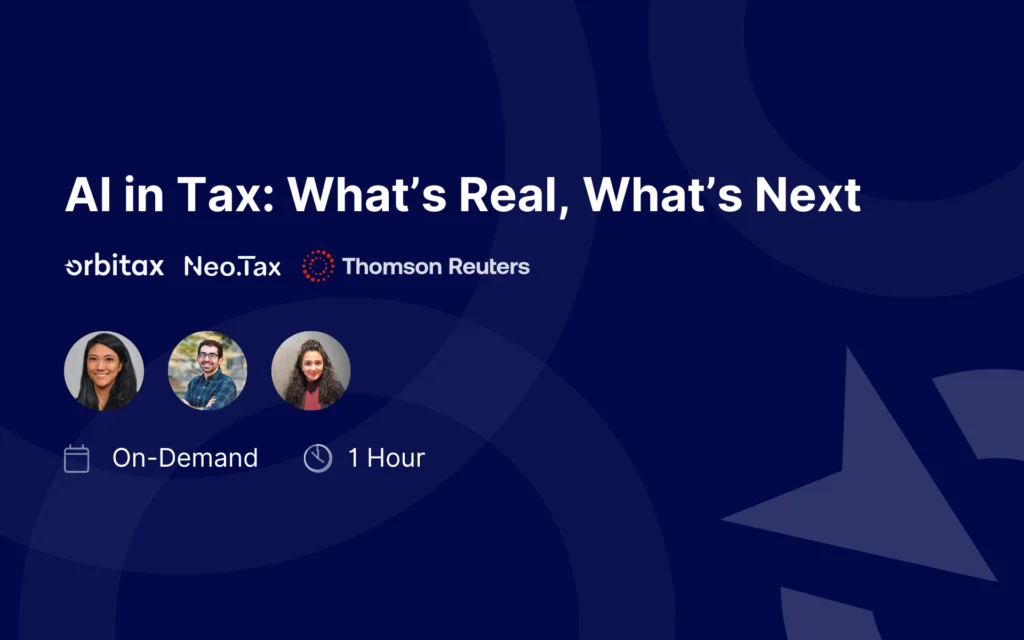Artificial Intelligence has become more than a buzzword in tax. As adoption accelerates, the conversation has shifted from “what if?” to “what now?” In a recent webinar with experts from Orbitax, Neo.Tax, and Thomson Reuters, we explored how AI is being embedded directly into tax tools, compliance processes, and strategic planning. The insights shared highlight how these technologies are already reshaping how tax professionals work.
Here are four key takeaways shaping the future of tax with AI:
1. AI is changing how we understand and work with tax data
At its core, a large language model (LLM) is a statistical tool trained on massive volumes of text. It breaks language into mathematical representations called embeddings, enabling it to understand and work with language in a structured way. Tools like XatBot, CoCounsel and Neo.tax are trained with specific tax data such as laws, treaties, commentaries, and filings.
With such applications, AI can now analyze the same types of inputs a tax professional would, but with greater speed and scale. For example, if asked about withholding tax rates or treaty provisions, an AI system can retrieve, interpret, and summarize the relevant rule, reducing manual research time significantly.
2. AI doesn’t just assist, it takes action
Tax teams are moving beyond simple question-answer interactions with AI. Agentic systems now allow models to trigger processes: retrieving documents, initiating workflows, or navigating software interfaces to act on behalf of the user.
This is the difference between passive intelligence and operational enablement. AI is not just interpreting the law, it can calculate exposure, filling forms, and driving compliance.
Orbitax’s XatBot exemplifies this shift. The assistant integrates with the Orbitax platform to automate routine queries and processes, turning what was once hours of manual work into seconds.
“
Fully embedded within the Orbitax International Tax Platform, the XatBot digital tax assistant provides instant, reliable answers to international tax questions by tapping into the Orbitax extensive.
Chief Operating Officer, Orbitax
”
3. Practical applications start with purpose
AI adoption does not need to be an overhaul. In fact, the most successful implementations start with focused use cases:
- Automating R&D tax credit documentation
- Extracting structured data from filings
- Cross-checking filing obligations across jurisdictions
- Monitoring changes to rules in real time
AI in tax is not about replacing humans, it is about giving them better tools to navigate complexity without compromising control or confidentiality.
“
AI is now starting to empower the professionals to move from routine tasks to more strategic roles.
Director of Product (AI& Platform), Thomson Reuters
”
4. Rethinking risk and responsibility in the age of GenAI
With powerful AI comes new accountability. Tax leaders must consider how AI is trained, what sources it uses, and how it handles sensitive information. Transparency, auditability, and explainability are now non-negotiables.
Professionals are shifting away from using public LLMs directly. Instead, they seek enterprise-grade models that:
- Restrict access to licensed users
- Log interactions for compliance
- Offer control over data residency and inputs
“
LLMs are inherently probabilistic, which means that they can hallucinate. However, if you install the right guardrails and ground the model in real data with structured inputs and outputs, you can guard against the vast majority of cases where an LLM might hallucinate. Ultimately, the AI model is only as good as the data you feed it.
Chief Technology Officer, Neo.Tax
”
To learn more about how AI is shaping the future of international tax, explore XatBot, the Orbitax AI assistant designed for smarter compliance.
Missed the webinar?
Watch it on demand here.
If you would like to dive deeper into what our speakers and their companies are building, here are a few helpful next steps:
- Orbitax – Create a free account to try XatBot, our AI-powered tax assistant, for free!
- Neo.Tax – Let AI do the work while you get the credit; no surveys, no interviews, just seamlessly automated R&D tax credits with Neo.Tax.
- Thomson Reuters – Curious about what’s top-of-mind for tax professionals today? Download the 2025 Future of Corporate Tax Professionals Report.






